Research shows that companies with engaged employees outperform their competitors. Read on as we share proven strategies for increasing workplace engagement to give your company the extra edge.
Most employees don’t show up for just a paycheck—they want to bring passion, energy, and innovation to their roles. And when they do? Team productivity and business performance can reach new heights.
Organizations with highly engaged workforces are better equipped to navigate challenges, adapt to change, and seize new opportunities in our complex market. By understanding how to engage your employees, you can create a more dynamic, productive, and mutually beneficial work environment.
Read on as we explore how to not only engage staff but also maintain long-term, fruitful workplace engagement.
Take a self-guided tour of ContactMonkey
See how our key features can streamline your internal communications.
Take product tour

What is Employee Engagement?
Employee engagement is the emotional investment and connection employees have to their organization and its mission. It goes beyond job satisfaction. It encompasses a deeper level of dedication and enthusiasm. This heightened level of commitment has numerous benefits for both the employee and the organization, including increased innovation, retention, and even customer satisfaction.
Employee engagement involves three key components:
- Cognitive engagement: How well employees understand their role and the company’s mission
- Emotional engagement: The passion and pride employees feel towards their work and organization
- Behavioral engagement: The effort and initiative employees put into their tasks
Why Your Company Needs an Employee Engagement Program
Implementing an effective employee engagement program not only has many benefits—it’s a critical component of organizational success. Employee engagement programs are designed to boost employee satisfaction and productivity. How you engage employees may include carrying out various employee activities in the office, updated work policies, and best practices that when combined make your people feel valued and appreciated.
Heightened levels of engagement translate directly into improved business performance because engaged employees are more productive, innovative, and committed to their roles.
Here are some key benefits of a robust employee engagement program:
- Increased productivity and efficiency
- Higher customer satisfaction and loyalty
- Enhanced creativity and creativity
- Reduced absenteeism and turnover
- Improved workplace safety and fewer incidents
- Better financial performance and profitability
- Increased unity in the workplace
Let’s break down why employee engagement is important and how you can keep employees engaged and motivated.
Start two-way conversations and employee feedback loops
Learn how to engage staff with pulse surveys, content ratings and reactions, custom polls, and more. Ready to send modern emails?
See engagement features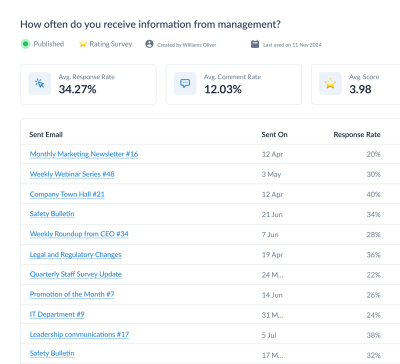
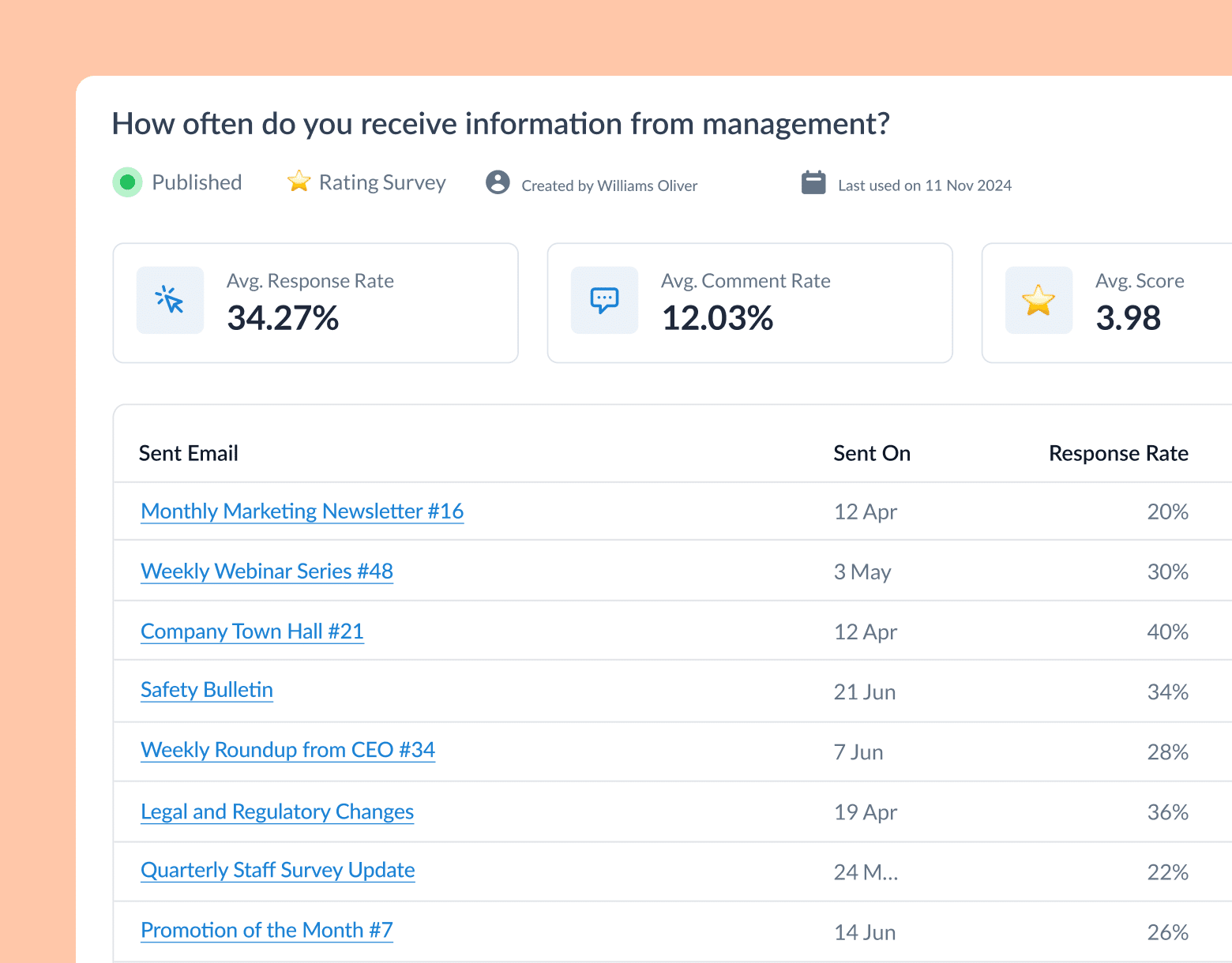
12 Strategies to Engage Employees at Work
How exactly you engage employees in the workplace may depend on your organization’s goals, size, and level of engagement or disengagement. Regardless of your company’s unique characteristics, there are tried and true ways to effectively keep your employees engaged. Employee engagement requires a multi-faceted, strategic approach.
Here are 12 proven strategies to increase employee engagement in your workplace—regardless of setting, injury, or current employee satisfaction levels:
1. Foster open communication and transparency
Open and honest communication is the foundation of employee engagement. Encourage regular feedback and create internal communication channels where employees can voice their opinions and concerns openly.
If you’re not sure which channel to opt for, you can conduct an internal communications audit to better understand your challenges, shortcomings, and successes.
For example, some teams may prefer internal emails, SMS communication, polls and surveys, or in-person conversations. Ask your workplace about their preferred communication methods and build out internal communication guidelines that include a variety of preferred formats and styles. This approach helps build consistency and trust among your employees and caters to more individual preferences. Here’s our extensive guide to internal communications that breaks down the different internal communication channels.
2. Implement an employee recognition and rewards program
In the search to find top talent, organizations and managers use many different strategies to attract and retain top performers while increasing productivity and financial performance. Employee recognition and rewards programs are an effective way to show appreciation for your team and celebrate individual and team success.
In a recent study by Gallup, it was found that the most common and memorable forms of recognition come from managers or CEOs in their organizations. It was found that 28% of managers recognize or praise their staff.
One of the most effective employee recognition is the kind that’s authentic and personalized to the individual. For example, you can offer your employees time off on their birthday or give a gift to someone who’s recently had a baby. Celebrating your employee’s professional and personal triumphs builds trust and connection and showcases how much they are valued. It’s a key way to engage and retain employees.
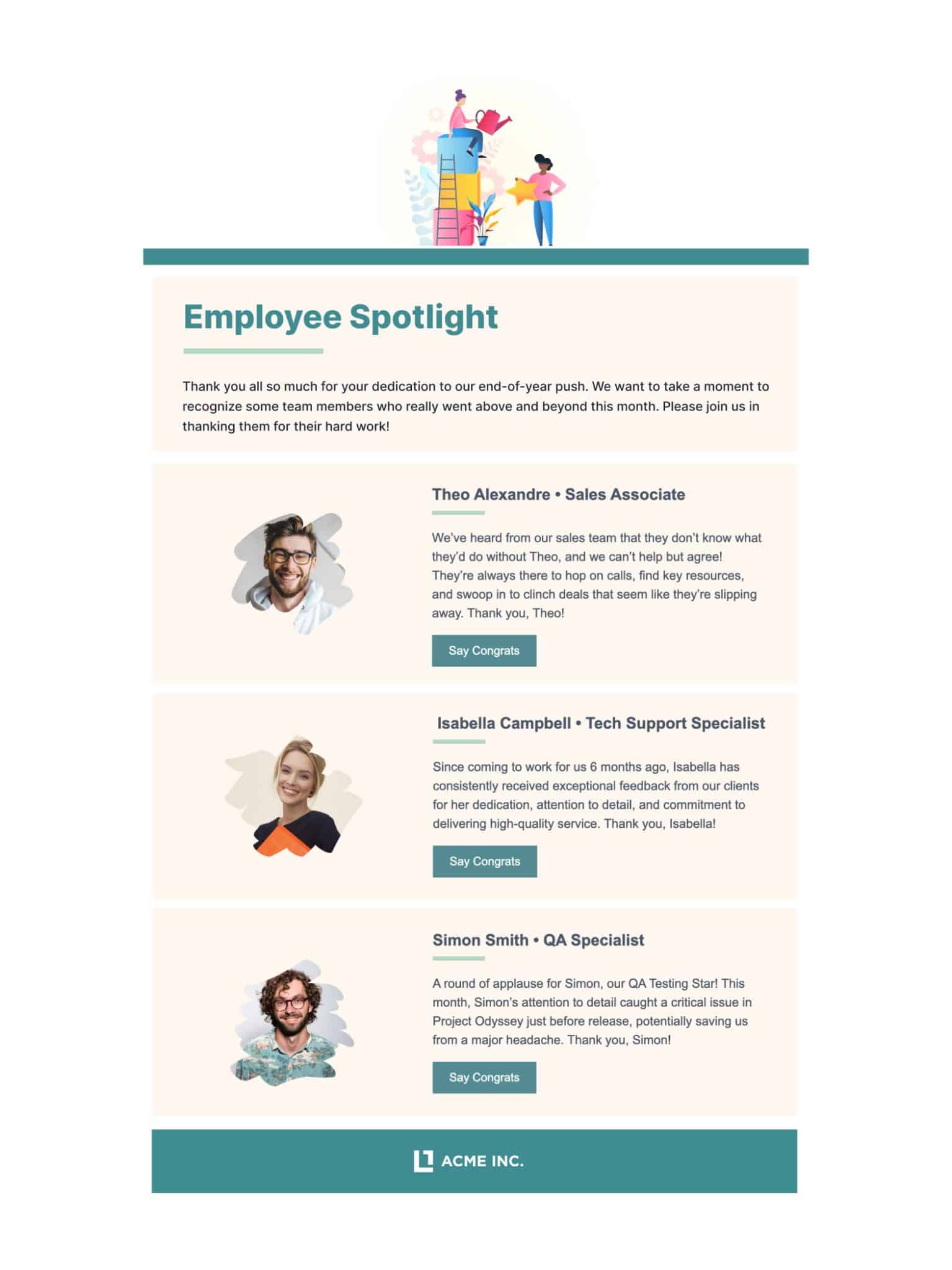
3. Enhance virtual and in-person meetings
When executed correctly, meetings can be a powerful communication tool. They’re essential for collaboration and decision-making in any organization. However, in order to keep employees engaged during meetings, you need to think more about the setting, length, purpose, and whether or not you’re baking in two-way interaction.
Here’s how to engage employees in meetings:
- Encourage active participation from your employees: Use interactive tools like presentation decks, quizzes, and polls to get the conversation flowing between teams or ask questions that encourage everyone to collaborate and share ideas.
- Prepare an agenda in advance: Let employees know the main objectives of a meeting so they can come prepared.
- Enable interactive breakout rooms in virtual meetings: To get employees involved, you can break down teams into smaller groups to get them talking virtually.
- Leave extra time for a Q&A: After your meeting is finished, let employees ask any questions to make sure everyone’s on the same page.
By taking a step back and treating meetings as strategic opportunities to better engage employees, you also create opportunities to consider the effectiveness of your current meeting strategies. If employees are visibly tuning out or the same participants are doing all of the talking, it’s time to deploy meeting engagement strategies.
Watch ContactMonkey LIVE in action
Join live demo
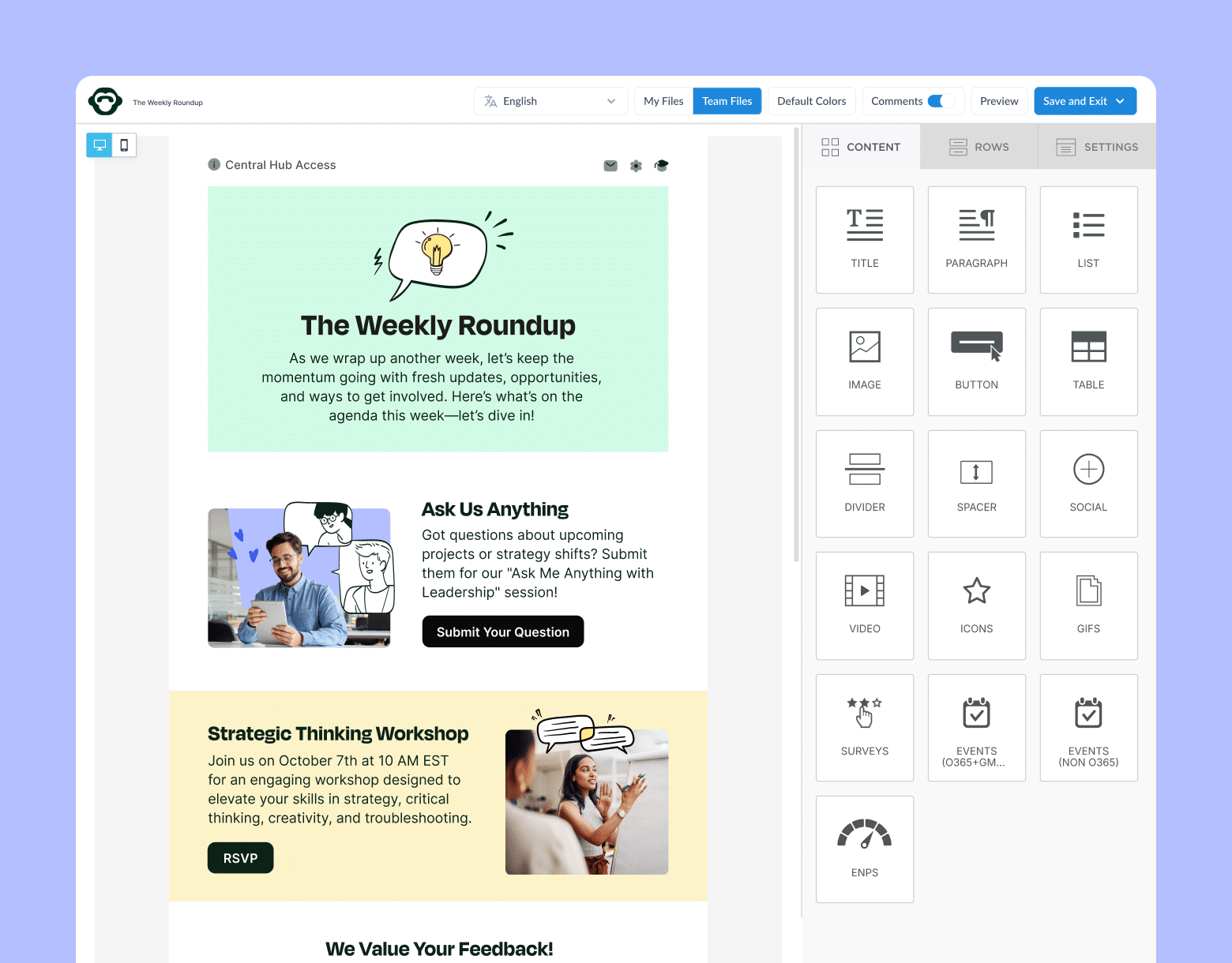
4. Encourage professional development and specialized employee training
Providing your employees with professional development and career progression programs not only enhances their skills and knowledge but keeps employees engaged in the workplace. Continuous learning opportunities and mentorship programs help with career advancement and provide a sense of accomplishment for your teams.
To help motivate your employees, you can gamify the professional development experience. For example, you can use quizzes, badges, points, leaderboards, hackathons or create team challenges. This makes learning more accessible and engaging while adding a competitive element to the mix.
Here are some examples of training and growth opportunities for professional development:
Mentorship programs: Pair employees with experienced mentors or peers to guide career growth and skill development. This engagement initiative is especially effective for new hires as they can ask for additional support during their first few weeks.
Workshops and seminars: Host regular in-house or external sessions focused on industry trends, skills, and best practices.
Cross-departmental training: Allow employees to learn from different departments to broaden their skill set and understand other aspects of the business. This also helps eliminate work silos
Hackathons or innovation challenges: Encourage creativity and problem-solving in the workplace with team-based challenges.
Personalized learning plans: Develop tailored learning and training paths for each employee based on their career goals and interests.
Soft skills development: Offer training on communication and presenting, teamwork, conflict resolution, and other essential soft skills to boost employee confidence.
5. Promote work-life balance and flexible working hours
The traditional 9-to-5 schedule is quickly becoming less common. By implementing flexible work hours, remote work options, and paid time off policies, you give your employees agency and flexibility around their own schedules. Not only does this encourage a healthy work-life balance, but it pays dividends for employee productivity and job satisfaction.
Consider offering various flexible work styles such as:
Flex-Time: A flexible work arrangement allows employees to choose their start and end times, as long as they complete the required hours and work.
Compressed Workweeks: This is a type of work week where employees work the same amount of full-time hours in fewer than the traditional five workdays, like four 10-hour days instead of five 8-hour days.
Job Sharing: This is when two or more employees share the responsibilities of a single full-time position, providing greater flexibility for everyone involved.
Unlimited Paid Time Off (PTO): A type of flexible leave policy where employees are not given a set number of days off per year.
Core Hours: Set mandatory hours for all employees to be available, with flexibility around the rest of the workday.
Results-Only Work Environment (ROWE): Focus on results rather than hours worked, giving employees complete control over their schedules as long as they meet their goals.
If you lead a hybrid or fully remote team, learn how to engage your remote employees in our guide.
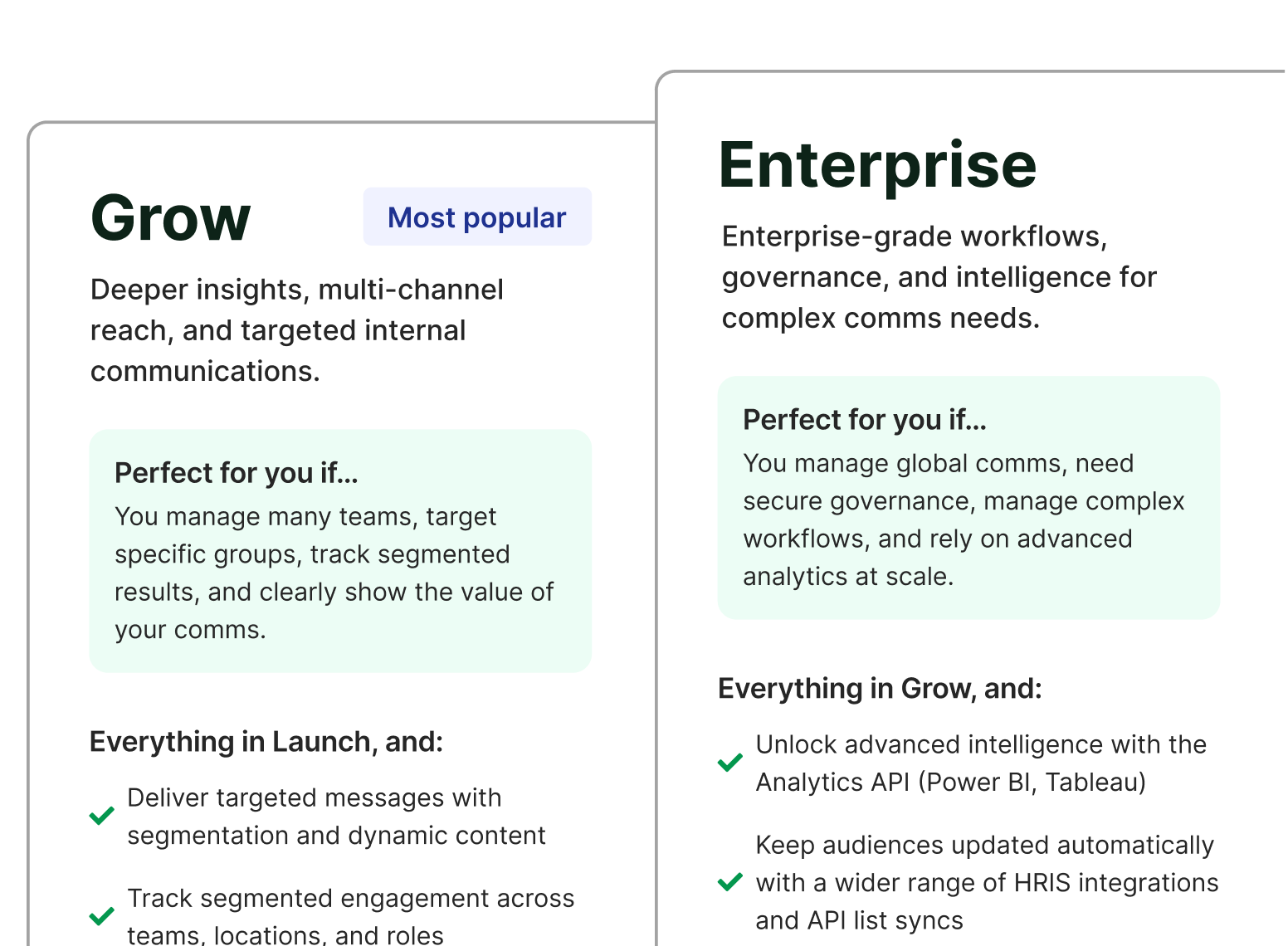
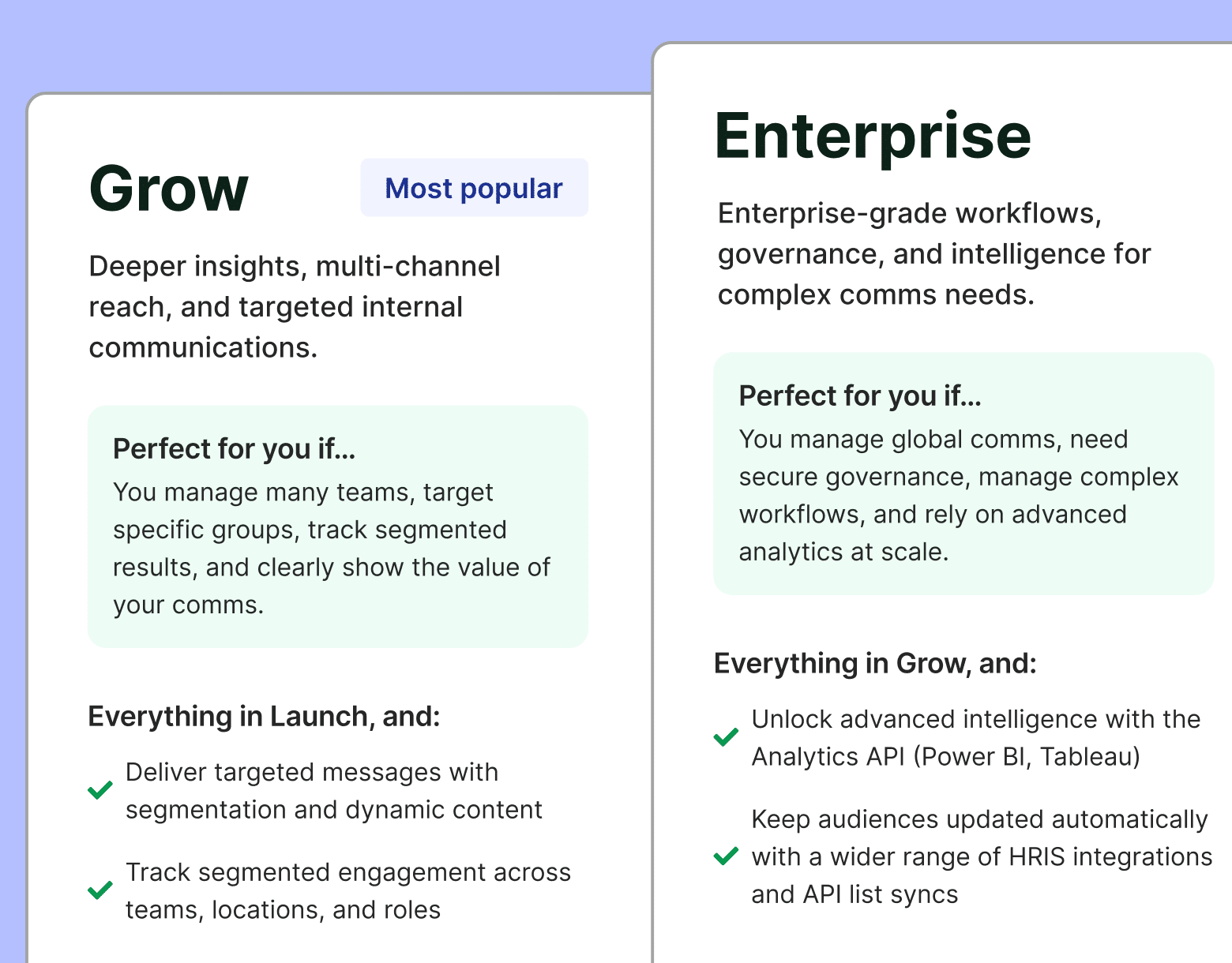
6. Actively build a positive culture and work environment
A positive work culture encapsulates many different things. It’s a workspace that promotes collaboration, creativity, and comfort among employees.
For example, if you have a hybrid team, you can organize bi-weekly or monthly team activities. This can include a team meal, lunch and learns, or a sip and share where your employees can bond and get to know one another. This fosters a sense of community and collaboration between teams.
A positive work culture can also include work perks like office snacks, a game room, or ergonomic furniture. Essentially, any type of added bonus that makes work more enjoyable contributes to a positive work environment.
Here are some specific, micro-level activities and ideas to build a positive workplace:
Daily or weekly check-ins: Hold brief, informal check-ins with team members to see how they’re doing, both personally and professionally. This shows care and helps address issues before they escalate.
Personalized workspaces: Encourage employees to personalize their workspaces with photos, plants, or decorations that reflect their personality.
“Kudos” boards: Set up a physical or virtual board where team members can leave positive notes or shout-outs for each other. Everyone loves a culture of appreciation and recognition.
Wellness breaks Encourage short, scheduled breaks where your teams can grab a coffee, go for a quick walk, or stretch. These breaks help employees recharge and reduce stress.
In-office hobby groups: Support the formation of hobby-based groups like book clubs, knitting circles, or running groups so staff from different teams can meet and bond.
Feedback Fridays: Dedicate a time each week for employees to share feedback, ideas, or concerns in a casual setting. This can be a short meeting or a virtual suggestion box.
7. Set clear goals and expectations for your employees
Setting clear goals and responsibilities is key for both organizational and employee success. They provide staff with direction and purpose while showing them how they contribute to the organization’s mission.
In order for anyone to measure progress in a work environment, goals must be trackable. This allows managers to review performance and make adjustments based on an employee’s results.
Here are a few ways you can track performance and goals with employees:
Key performance indicators (KPIs): KPIs are measurable values that help businesses evaluate how effectively employees are achieving their objectives. KPIs provide insight into performance across various areas, helping organizations make informed decisions, improve processes, and achieve strategic goals.
For example, if you have a sales team, you can track the number of units sold or the total value of sales generated by an employee. Based on these numbers, you can accurately see how revenue is growing over a period of time.
Objectives and key results (OKRs): OKRs are a type of goal-setting framework that helps employees define, track, and achieve their goals by setting clear objectives and measurable outcomes. OKRs are widely used in various industries to align individual, team, and organizational goals and ensure everyone is working toward the same priorities.
Objectives are a clear and concise statement that describes what needs to be achieved while the key results are clear and measurable outcomes that indicate the outcome.
For example, if a customer success specialist wants to increase customer satisfaction in the next quarter, they can ensure all support tickets are handled within a 24-hour period to ensure customer retention.
Performance reviews: Performance reviews come in various formats, each serving a specific purpose depending on the organization’s goals, culture, and the nature of the job. They can include traditional employer-employee performance reviews, as well as 360-degree feedback reviews, self-assessments, and peer reviews.
Project-based reviews: These types of evaluations focus on an employee’s contributions to specific tasks and projects. They assess how well an employee performs during a project lifecycle, from ideation to completion. Some key focus areas include technical skills, time management, quality of work, and problem-solving.
8. Practice diversity, equity, and inclusion in the workplace
Creating a diverse, equitable, and inclusive workplace requires more than just checking a few boxes. Diversity, equity, and inclusion (DEI) are the three main pillars of a sense of belonging within an organization. When employees feel they’re respected and valued for their individual differences, it changes the way they perform at work.
Here are some simple steps to building a DEI plan:
Identify DEI priorities within your organization
A DEI audit provides a comprehensive understanding of the current state of diversity, equity, and inclusion within your organization. You can start by conducting interviews or focus groups with employees to gather qualitative insights. Analyze your data on hiring, promotions, pay equity, and employee turnover to identify disparities.
Create a DEI plan for your workplace
This step will look different for most companies. But, once you’ve identified your areas of improvement, you can build out a plan that tracks DEI priorities. This can include financial and non-financial resources that will help support events and initiatives, metrics that assess and report on progress, and systems in place to gather employee feedback.
Set clear expectations to keep the plan in motion
In order for DEI to take off in the workplace, expectations should be set from the beginning on both an individual and collective level. With the help of leadership, they can hold themselves and employees accountable.
Create and send employee surveys for feedback
Engage staff with pulse surveys, eNPS surveys, reusable surveys, custom polls, and more. Ready to send modern emails?
Explore survey features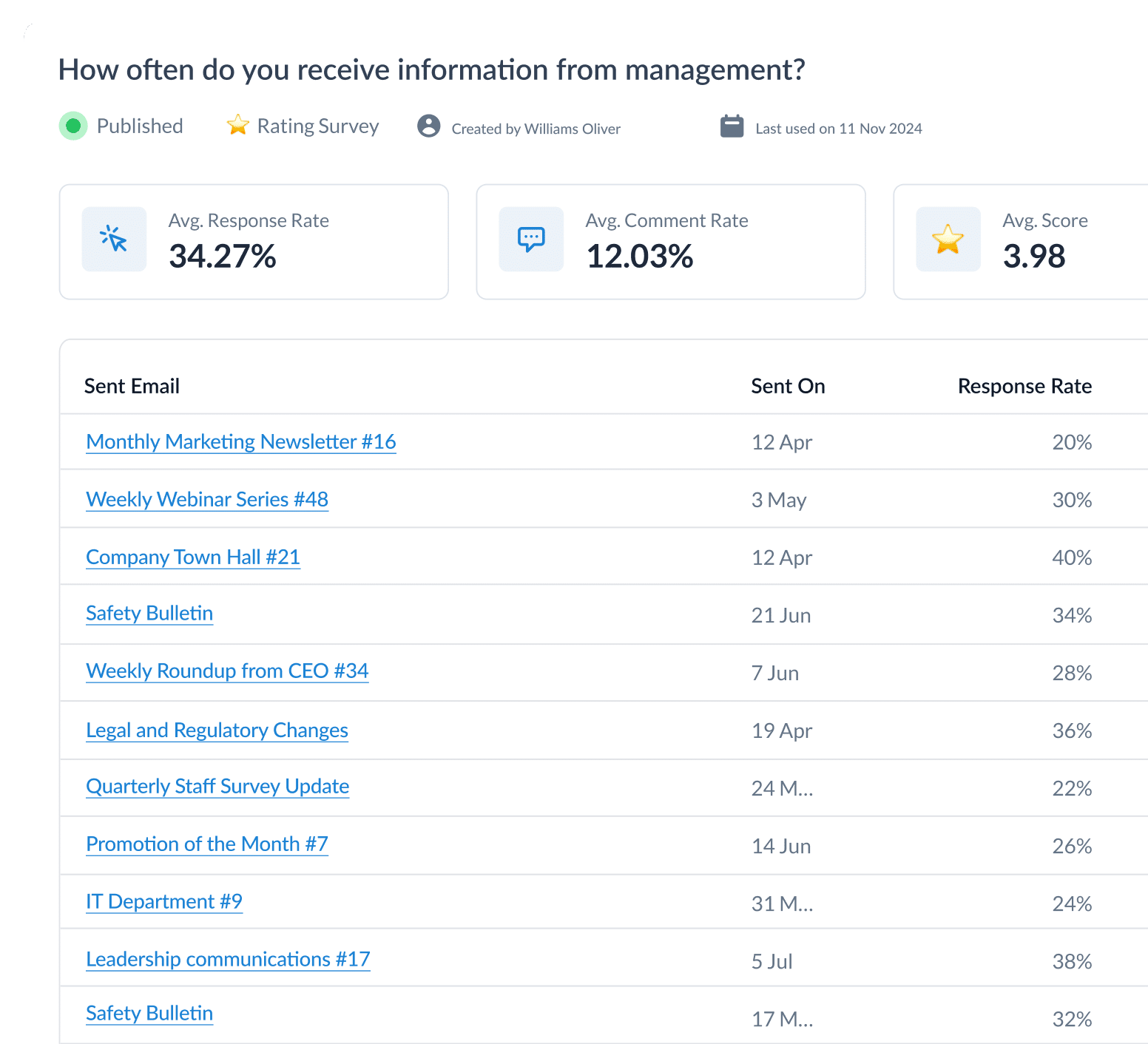

9. Tailor communication styles for remote workers
Remote work has become increasingly prevalent in today’s professional landscape. However, engaging employees who work remotely comes with its own set of challenges.
Here are some tips on how to engage employees virtually:
- Schedule regular video one-on-ones and team meetings to maintain face-to-face interactions
- Send out interactive email newsletters and polls to gauge employee engagement
- Organize virtual team-building activities to strengthen employee relationships
- Provide flexible work hours to accommodate different time zones
10. Stay ahead of organizational changes with transparent and regular communication
Change is inevitable in any organization, whether it involves restructuring, adopting new technologies, introducing new processes, or shifting marketing strategies. Successful change management communications requires not only effective planning and execution, but also engaging your employees throughout the process.
Keeping your employees in the loop breeds trust in the workplace. Here are some tips on how to keep employees engaged during change or transitions:
- Use internal communication tools to keep employees up-to-date on any changes
- Involve employees in the change process by asking for their feedback
- Provide resources and support to help employees adapt to changes
- Celebrate milestones and successes throughout the change journey
See how employee engagement and technology work together to create a more connected workforce.
11. Improve the hybrid office experience for employees
Over the last several years, hybrid work has become the most popular corporate work model. It’s a combination of both in-person and remote work. Despite being the best of both worlds, hybrid workplaces still present their own challenges.
So, how do you engage hybrid employees?
When you have a hybrid team, it’s important to connect with everyone during the work week. For example, if all your teams are in at the same time on a specific day, try hosting a meeting so everyone can chat in person. This helps foster a feeling of collaboration and connection, especially for any upcoming projects and tasks.
If you have employees who come into the office, create a digital hub and source of truth for company news so everyone can stay up-to-date. It’s essential that both remote and hybrid employees are on the same page regarding any updates.
12. Streamline onboarding processes for new hires
An effective onboarding process not only helps new employees acclimate quickly but also boosts their engagement, productivity, and long-term retention. Streamlining this process is essential to ensure that it is efficient, consistent, and impactful.
Here’s a simple outline of how to get employees engaged in training and onboarding:
Provide pre-boarding materials
One of the easiest ways to prepare your new hires is to set them up before their first day. For example, provide them with a welcome email that includes essential information including start date, schedule, company policies, and necessary paperwork.
Next, virtually introduce them to anyone on the team so they familiarize themselves with their coworkers before their first day.
Keep administrative tasks and forms in one place
Centralize your documentation and store all onboarding resources in one accessible location so your new hires can review them at any time. This can include any company policies, benefits forms, and other training materials.
Implement a standardized training program
Develop training modules that cover essential topics like specific skills and compliance training. This ensures your new employees learn the same information and apply it to their tasks. Onboarding doesn’t end after the first week, so don’t forget to continuously check-in and provide ongoing support where you can.
How Your Company Can Use ContactMonkey to Engage Staff
There’s no quick fix to keeping your employees engaged in the workplace. That’s why it’s key to develop a robust internal communications strategy that shows how invested you are in your employees’ well-being and happiness.
ContactMonkey is a powerful internal tool that allows you to design engaging communications that revolutionize your employee engagement efforts. Send out beautifully crafted emails and newsletters, easy-to-use pulse surveys that capture employee feedback and opinions, and track how employees interact with your communications.
Highlight your top employees, promote fun events happening within the organization, or create interactive surveys asking for employee feedback. With these strategies in place, you can engage both your hybrid and remote employees in the workplace.
Use real-time analytics so you can track open rates, click-through rates, read times, full heat maps, and even learn which devices your employees use. Based on these metrics, you can see who’s engaging with your emails and newsletters and make improvements from there.
Take the guesswork out of your internal communications strategy and boost employee engagement in the workplace with ContactMonkey.
Ready to take your employee engagement efforts to the next level? Book a demo with our employee engagement experts today to learn our cutting-edge tools and strategies so you can learn how to keep employees engaged at work.



